Archive for ‘Psychological’ Category
Toxic Productivity Part 5: Technology and a Hungry Ghost

THE MANY TENDRILS OF TOXIC PRODUCTIVITY
I checked in with a friend the other day to see how her new job was going. Her company, an international conglomerate, had laid off several people over the past six months, including my friend, but also did some internal hiring. She’d been excited about getting the new job, but seemed blue when we spoke.
“I’ll be honest,” she told me, “if I hadn’t already worked for this company for years, I’d think I was incompetent. This is really hard.” My friend, a veteran of many, many promotions for merit, is definitely not incompetent. It turns out that only one person had ever held this position before, and was fired after being unable to keep up with the demands.
When I hear these stories from my clients, the first thing I do is get a sense of whether the problem is that someone needs more support or guidance at work. In terms of support, even though she’s at the same company, my friend’s work situation is different, and she’s no longer got the support of a team structure; rather, everyone is on his or her own, with no cross-training and no backup. The company still seems to have unreasonable expectations of how much can be humanly accomplished, as we discussed at the start of this series, in Toxic Productivity In the Workplace and What Comes Next.
Next, she and I talked about the Pareto Principle (AKA: the 80/20 Rule, which we discussed last week in Toxic Productivity, Part 4: Find the Flip Side of Productivity Hacks) and I asked my friend if she’d talked with her boss about priorities, and what the most important aspects of the job needed to be right now.
Remember, 80% of the success comes from 20% of the effort, so finding that 20% can eliminate a lot of the stress and busy-work, creating more mental energy to tackle other aspects of the work.
The Pareto Principle says 80% of the success comes from 20% of the effort, so finding that 20% can eliminate a lot of the stress and busy-work, creating more mental energy to tackle other aspects of the work. Share on XI pointed out that, as a valued employee, and as the second person to try to tackle this role, she might be in a position to (gently) point out these unreasonable expectations. (Yes, this is a touchy issue, but it’s the best way to determine if the problem is bad management practices or merely lack of corporate awareness of how many human-hours it takes to accomplish certain tasks.)
My friend then noted that a colleague of hers, another “island” unto himself in a position similar to herss, has been in his role for about a year and a half. Apparently, this guy regularly works until midnight and starts again before traditional work hours, and works through the weekends.
If you’ve been reading this series all the way through, you may agree with me that this is a sign that the worker has internalized the unsustainable expectations and toxic productivity demands of the company.
This isn’t just a problem for my friend’s co-worker. Yes, he’ll probably burn out, which will be bad for him. It’s bad for my friend (and everyone else at her level) because workers with families, non-work obligations and, y’know, lives, can’t reasonably live up to this automaton-like worker-bee behavior. Nor should they try. So, the worker who has internalized toxic productivity (and who may or may not have productivity dysmorphia), is contributing to the escalating expectations for unsustainable productivity throughout the division, even throughout the company!
In other words, he’s screwing over his colleagues, who are now left positioned between having inferiority complexes and developing productivity dysmorphia to compensate (thereby risking their own mental health, their relationships, and more) or having to leave the company feeling like failures, and the company will need to hire new workers and the cycle will begin again. Oy.
Such is the state of many modern workplaces. Terrifying, isn’t it?
And, as we have discussed over the last several weeks, a corporate structure isn’t necessary for this to take place. There’s a hustle culture out there for all of us who work on our own, solopreneurs and small business owners alike, who are cowed by common practices into believing that nothing we are doing is enough, and that we need to keep up with the Joneses (our colleagues or competitors, and not merely our neighbors) at all cost.
EMBRACE NEW VALUES AND PRINCIPLES
The drive to deliver — to produce — misses the point. I posit that as much as you may (or may not) enjoy creating, your purpose on the planet isn’t to produce documents or deliver services or create or to make money. Your purpose is to enjoy yourself and help the people you love enjoy themselves, too.
We’re here to be fulfilled, not to produce widgets, and if enough of us demand that we be treated (and treat others) as humans rather than producers, we might achieve this very thing.
This can feel like pretty hippy-dippy advice in 2022, but I stand by it.
So, first, let’s start with the wisdom high performance coach Sarah Arnold-Hall puts forth about results, not hours.
Let’s start valuing results created, not hours worked. pic.twitter.com/yebU0Zwrq8
— Sarah Arnold-Hall (@saraharnoldhall) May 13, 2022
Now, on its own, this could create a huge feedback loop into productivity toxicity. Produce more, create more, do more! Grrrr. Arrrrrgggh. But we’re not going to do that.
Instead, we’re going to bear in mind what we learned in Toxic Productivity Part 2: How to Change Your Mindset about the necessity of downtime. Those hours when we’re not working are as important as, if not more important than, the hours we are working.
The task-positive brain network, which we use to take all of our accumulated knowledge and turn it into something useful, helps us focus our attention, arrive at solutions to problems, and confidently make decisions. But we can’t do any of that if we don’t also make use of our default mode network, the way our brain blisses out and thinks about anything except the problem at hand when we’re sleeping, resting, relaxing, and enjoying our loved ones and life.

So, once you accept that success isn’t about the hours worked but the worth of what you’ve done in those hours, you have to pivot to understanding that more and more of your hours have to be given over to the downtime that allows you to create anything worthwhile. Recognizing the finitude of life is key to that attitude change. (Remember that when you get to the end of this post!)
So, what have we learned about healthy productivity?
- It’s not about spending all of your hours on work.
- To make the work you do accomplish valuable, you need to change your mindset and have more downtime.
- Downtime isn’t scrolling through TikTok or Netflix, but truly letting your brain rest and recover — through non-competitive exercise, better sleep, eschewing multitasking, increasing opportunities for a quiet mind, and asking yourself the essential questions about the life you’re currently living and how it compares to the one you truly want — as we discussed in Toxic Productivity Part 3: Get Off the To-Do List Hamster Wheel.
- We can use the same productivity tools designed to help us overcome procrastination and get more done to slow ourselves down to the speed of life. This includes embracing better and smaller (atomic) habits, using the Pareto Principle to focus on what’s truly worthy of being a priority, employing the Pomodoro Technique and block scheduling to focus our work time and ensure our break time.
— Liz Fosslien (@fosslien) June 23, 2022
What else can we do?
CONSIDER TECHNOLOGY’S ROLE
It’s easy to think that technology is essential to productivity. Look at how much more humanity accomplished after the Industrial Revolution vs. when we had an agrarian society. How much more could we accomplish with telephones than when we had to wait for the postal service or telegrams? Certainly we got much more accomplished once we added email to our resources, right? (cough, cough) And surely we’ve reached a pinnacle of productivity now that we have Slack and Asana?
Hopefully, you detected my sarcasm. Yes, technology yields vast improvements in our ability to communicate quickly (if not always clearly, as the multigenerational confusion over emoji and whether ending sentences with periods is an insult have proven), but all of these aspects of technology have led to the always-on misery we discussed at the beginning of the series. France gets it; most of Europe gets it. The US does not yet get it.
We have an inalienable right to disconnect, but it’s going to take all of us, together, to stand up and keep secure that right.
Communication technology is not the only problem.
Along with communication technology, these last few decades have seen a growth in productivity technology, from software and apps that help us brainstorm, assign ourselves (and others) tasks, and conquer our foibles and deficiencies in terms of procrastination, motivation, focus, capturing information, organizing our thoughts, collaborating on projects, and so on.
I am not a Luddite. I believe in the power of technology to make things easier, but sometimes we’re making the wrong things easier. Take collaboration. While Thomas Jefferson wrote the original draft of the Declaration of Independence, historians (including Pauline Maier in American Scripture: Making the Declaration of Independence) have shown how the handwritten edits suggested by the members of the Second Continental Congress became a complicated collaboration.
 In a document listing colonial grievances against the King George III, members of the Congress made Jefferson take out references to slavery and put in references to a Supreme Being (and fishing rights). The handwriting was that of Secretary Charles Thomson; he controlled the document’s additions, deletions, and revisions requested and/or demanded by the cacophony of voices representing 13 colonies.
In a document listing colonial grievances against the King George III, members of the Congress made Jefferson take out references to slavery and put in references to a Supreme Being (and fishing rights). The handwriting was that of Secretary Charles Thomson; he controlled the document’s additions, deletions, and revisions requested and/or demanded by the cacophony of voices representing 13 colonies.
Now imagine that same collaborative product in Microsoft Word’s Track Changes or Google Docs’ comment section. Now multiply the different voices and competing methods listed on this Wikipedia entry listing types of collaborative software. (I’ll wait while you scroll.) If you know how to be productive in one technology, you might still be flummoxed in another.
The number, variety, complexity, and interoperability (and lack thereof) of technology solutions can be overwhelming.
Have you ever heard about a new task app and wondered if it could be the solution to all of your troubles? Have you tried Todoist? Anydo? TeuxDeux? Remember the Milk? Things 3? Google Tasks? What about more complex productivity suites, like Basecamp? Trello? Clickup? Asana?
In case you were wondering if I’d suggest one app to rule them all, I’m afraid that’s not the case.
The truth is, the best productivity app is the one you’ll use. The one you’ll commit to learning, commit to using, and the one you won’t “cheat” on when another shiny app starts flirting.
The truth is, the best productivity app is the one you'll use. The one you'll commit to learning, commit to using, and the one you won't 'cheat' on when another shiny app starts flirting. Share on XUnfortunately, some productivity technology overwhelms even the most diligent users. This may be because the information we get out of our productivity technology is only as good as the information we put in, and we humans are already overwhelmed.
All of these apps, working at the speed of light (and life), can’t prioritize for us. We capture tasks with the click of a button, but we are so pressed for time (and productivity) that we fail to take the requisite moments to figure out what work has value and what is busywork.
So, are we supposed to get rid of technology altogether to combat toxic productivity?
Remember how I said I wasn’t a Luddite? Well, I’m not asking you to be one either. Chances are, if you work for a company that you don’t own, you’re stuck with some technology required by your workplace. But in the areas where you do have control over which types of technology you use, I often suggest that my clients put technology completely aside for a little while.
If you’ve got a task app or other tech that works well for you, stick with it. But if you feel beaten down and bruised by the very tech that’s supposed to keep your head above water, try slowing everything down.
- Go analog with your time displays. Wear an analog watch, or set your fancy Apple Watch or Fitbit to display time in an analog manner. Do the same with the display for the clock app on your phone. Seeing time as it ticks by will help you appreciate the finitude of time and feel more in tune with how much you can reasonably accomplish in an hour or a day. (You might want to brush up on Back-to-School Solutions for the Space-Time Continuum for more ideas.)
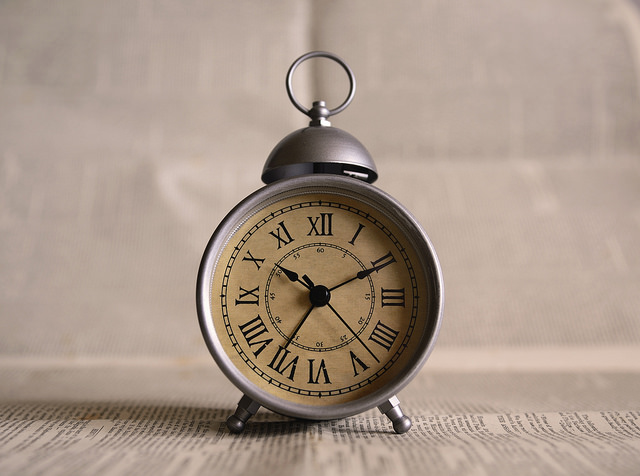
- Opt for paper over tech to learn key productivity skills. I’m a Certified Evernote Expert, so I realize all of the excellent benefits of collating your clipped websites, inbound emails, saved articles, etc., digitally, tagging them, and organizing them into notebooks. But when you’re overwhelmed, sometimes having your resources, your printed instructions, and other task-triggering action paperwork right in front of you, without need for WiFi or even electricity, can help you slow down and focus without the buzz of the digital world.
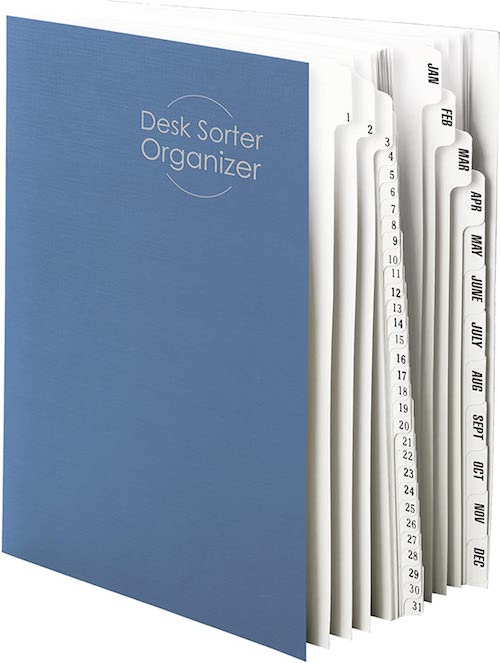
One of the many reasons I recommend tickler files for my overwhelmed clients is that learning the process of looking at task-triggering papers and making qualitative decisions (regarding priorities) and chronological decisions (regarding when you can reasonably accomplish specific tasks) is an essential skill for improving productivity in a healthy way. It’s the reason I wrote Tickle Yourself Organized.

- Consider bullet journaling. I’ll be honest, bullet journaling stresses me out. I understand that it’s not necessary to embrace the fancy, artistic designs some people use, but the very hands-on, tangible customization options overwhelm me, and the idea is to achieve healthy productivity by removing overwhelm. But I’m not you. Hundreds of thousands, perhaps millions, of people swear by bullet journaling for tracking tasks and other information. They can’t all be wrong.
PULL IT ALL TOGETHER AND HALT A HUNGRY GHOST
Hopefully, over this past month, you’ve come to recognize that not only are you not a robot, but that it’s unacceptable for anyone — your company, your clients, your mother-in-law, or you — to expect non-stop labor from you.
If machines don’t operate at 100%, why do we expect so much from ourselves?
— Junhan (@junhanchin) May 24, 2022
You’re a living, breathing human being. But you may have a ghost in your machine.
In Brad Stulberg‘s recent post The Constant Restlessness You Feel Has a Name, he describes how many of us experience a constant grind he calls “heroic individualism.”
Heroic individualism says that you will never have enough, be enough, or do enough. It is an endless gauntlet of more. While it may lead to decent short-term performance, long-term, it is a recipe for disaster. This is because long-term fulfillment depends upon things that are inherently inefficient and unproductive, at least on acute timescales.
Sound familiar?
When you look at the ten symptoms of heroic individualism that Stulberg lays out, some of it bears a striking resemblance to toxic productivity and Anna Codreo-Rado‘s perception of productivity dysmorphia, such as:
- Low-level anxiety and a sensation of always being rushed or in a hurry — if not physically, then mentally.
- Not always wanting to be on, but struggling to turn it off and not feeling good when you do.
- Feeling too busy, but also restless when you have open time and space.
- Successful by conventional standards, yet feeling like you’re never enough.
Stulberg’s describes the Buddhist concept of the hungry ghost:
The hungry ghost has an endless stomach. He keeps on eating, stuffing himself sick, but he never feels full. It’s a severe disorder.
The modern world that so many of us inhabit depends on the creation of hungry ghosts. But you, me, all of us can choose to opt out of this game. We don’t have to become hungry ghosts. We simply need to step back and reflect upon what it is that we actually want. Simple, sure. But not necessarily easy.
To combat this hungry ghost, this toxic productivity, this productivity dysmorphia, Stulberg recommends the concept of groundnessness.
His book, The Practice of Groundedness: A Transformative Path to Success That Feeds—Not Crushes—Your Soul, combines research from psychology, neuroscience, and sociology (as we looked at in the first three posts in this Toxic Productivity series), as well as religious and philosophical teachings from Buddhism, Taoism, and our old friend-of-Seneca, Stoicism.
Toxic Productivity, Part 4: Find the Flip Side of Productivity Hacks
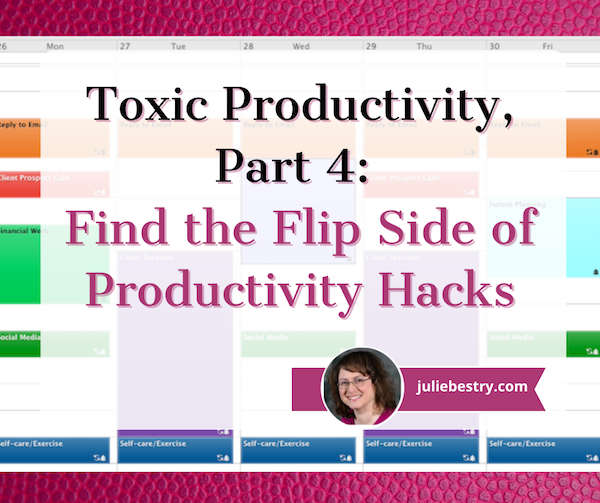
If you reside in the United States or Canada, you’re coming off the end of a long holiday weekend, an opportunity to rest, relax, and regenerate.
Do you feel relaxed? Or do you feel the itch to be accomplishing something on your to-do list? Do you feel that whatever you got done last week might not quite be enough, and that by taking an actual weekend off — not just two whole weekend days, but an extra holiday — you’re coasting? Cheating? If so, you definitely won’t be the only one.
PREVIOUSLY ON PAPER DOLL…
Throughout this series on toxic productivity, we’ve looked at what society can do to vanquish unsustainable expectations, how we can change our outlook and mindset, and what we can physically do to loosen the ropes with which we’ve bound ourselves. Before we go any further, I encourage you to catch up on the concepts and references we’ve looked at so far:
Toxic Productivity In the Workplace and What Comes Next
Toxic Productivity Part 2: How to Change Your Mindset
Toxic Productivity Part 3: Get Off the To-Do List Hamster Wheel
We can lobby for changes in societal expectations regarding excessive corporate demands on our productivity. We can read wisdom (and get therapy) to examine how we’ve internalized toxic belief systems and developed, as Anna Codrea-Rado calls it, productivity dysmorphia.
We can even recognize the finitude, or shortness, of life, and get off the hamster wheel by adding mindfulness and rest (in terms of non-competitive exercise) and more recuperative sleep, eliminating multitasking, and digging deeply to figure out what we want out of life and who we are.
But if none of that floats your boat, even if I’ve convinced you that toxic productivity is a danger to you, your loved ones, and society, these measures may just be too hard to incorporate in the life you’re already living. Trust me, I get it.
USING THE PRODUCTIVITY HACKS YOU KNOW AND LOVE
So, today, we’re going to look at the same productivity strategies, tactics, and “hacks” that are recommended to conquer lack of productivity — whether that’s a problem with procrastination, prioritization, or planning —and see if we can find ways to use them to stem the tide of toxic productivity.
Start At the Atomic Level
In James Clear‘s Atomic Habits, he posits that all of our outcomes — our productivity (for good or ill), our self-care, our financial state — are a “lagging result” of our habits. In other words, there’s a cumulative effect of what we do that, when repeated over and over, leads to where we’ve arrived.
To achieve what we want, Clear believes that we generally either try to change our habits in the wrong way, or we try to change the wrong things. Clear notes that we approach things in three ways:
- We try to change our outcomes (achieve more work, make more money, lose a certain amount of weight).
- We try to change our habits.
- We try to change our identities — including our belief systems, our views of the world, and our self-images.
Toxic Productivity Part 2: How to Change Your Mindset
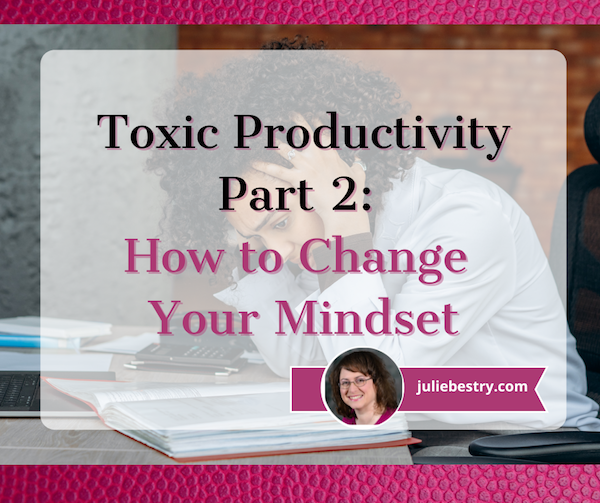
Last week, in Toxic Productivity in the Workplace and What Comes Next, we addressed systemic toxic productivity, when the workplace demands a seemingly endless series of achievements, undue (and unreciprocated) loyalty, and more of one’s heart, soul, and time than is reasonable. We also touched on the concept of personal toxic productivity, or productivity dysmorphia.
Going forward, we’re going to look at what we can do to give ourselves some grace and separate our productivity from our identity. Today, we’re focused on changing the way we think about ourselves and what we accomplish.
But first, let’s look at three stories that illustrate what toxic productivity is not.
WHAT TOXIC PRODUCTIVITY IS NOT
Story #1: At the end of April, my delightful colleague Linda Samuels wrote a blog post entitled How to Successfully Let Go Now Even If It’s Only For Today. In that post, she described how she enjoys getting things accomplished and often feels compelled to do so. She had a list of what she intended to accomplish on that particular Sunday, but was beckoned by the beautiful spring wearther and instead enjoyed a day in nature with her husband. In my blog comment, I gently teased her:
LOL, I’m glad you let go, but I think I see your problem right away, Linda. You had a to-do list for a Sunday. Sunday is the weekend. You’re not supposed to DO anything on the weekends except eat, play, and be entertained in the first place! 😉 No housework, no work-work, just enjoying yourself. I’m glad you let go; now we need to help you plan letting go as your weekend task so you don’t even try to work!
Linda is not an example of toxic productivity. She’s self-driven, but she also knows how and when to let go and grant herself buffer time to enjoy life.
Story #2: Another colleague (we’ll call her X), is a real go-getter. She had been working to create a virtual course, but has not yet made it go live because she’s so busy with her client load and is booked through the end of the summer. Disappointed that she hasn’t completed this combined educational/marketing tool, we’ve pointed out that the whole purpose of making people aware of one’s expertise is to get clients, and she already has more clients than spaces on the calendar! The girl is in serious demand!
Meanwhile, a few months back, X contracted COVID. Luckily, she had very mild symptoms, but of course she was quarantining. With no work to do, she headed outside and spent her quarantine weeding her garden! (Apparently, X didn’t know that the only acceptable reaction to being ill is to mope, wear fuzzy socks, and intersperse reading trashy magazines with bingeing guilty pleasure TV!)
X is also not an example of toxic productivity. She’s a product of a particular cultural background that especially prizes hard work and efficiency, but she also enjoys vacationing with her husband and entertaining friends around her pool.
Story #3: My BFF is a full-on, leaning-in career woman now that her children are all grown, but I recall a time when, for the 43rd conversation in a row, I was giving her a hard time about working so hard. She was raising four kids, volunteering in many realms, and though she had a bad case of bronchitis, was — as I was speaking with her on the phone — making cupcakes for a school bake sale!
As only a BFF can push, I pointed out that 1) she was sick and did not need to be doing anything for anyone else, 2) she could have sent her husband to the store to buy cupcakes, and 3) nobody wanted her bronchitis-germy cupcakes anyway! (I’m sure my voice went up three octaves by the time I got to the end of my diatribe.)
If I didn’t know better, I might think my BFF might be an example of toxic productivity. But she’s actually an example of systemic expectations of mental load, emotional labor, and American women unintentionally embracing the societal view that a woman’s value is based on what she does for others. (For superb writing on how to counter this, check out Emotional Labor: Why A Woman’s Work Is Never Done and What To Do About It, by my colleagues Regina Lark and Judith Kolberg.)
Paper Doll on the Magic of Making Lists

THE APPEAL OF A LIST
Paper Doll is a sucker for lists.
My childhood diaries (y’know the kind, pink with a lock that could easily be opened by a bobby pin) were just page after page of my mini-me wishes and hopes.
One of the first organizing-related books I ever purchased (when I was still in high school, back when dinosaurs roamed the earth and the top song on the Billboard charts
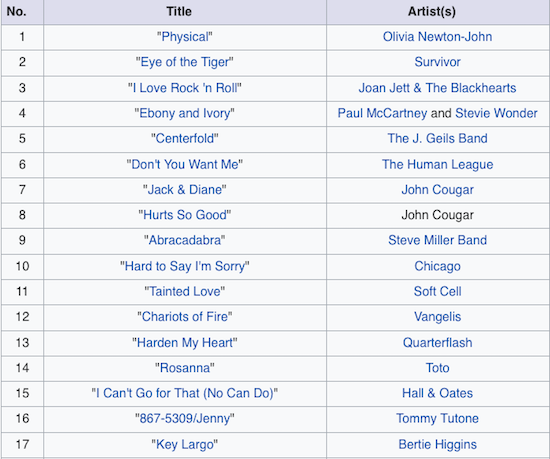
was Olivia Newton-John’s Physical), which still sits on my bookshelf, was Checklists: 88 Essential Lists to Help You Organize Your Life. It contains a wide variety of lists my 15-year-old self assumed would be, as the book title indicated, essential for becoming an adult.
Many of the lists were, and still are, useful. The “What To Do” checklists started with life transitions like how to find a roommate, plan a wedding, prepare for having a baby (or adopting one), buy a new or used car, or get ready for a move. These continued on through less happy events, like what to do if you’re going through a separation or a divorce, are a victim of a burglary, have to stay in the hospital, or need to plan funeral arrangements.
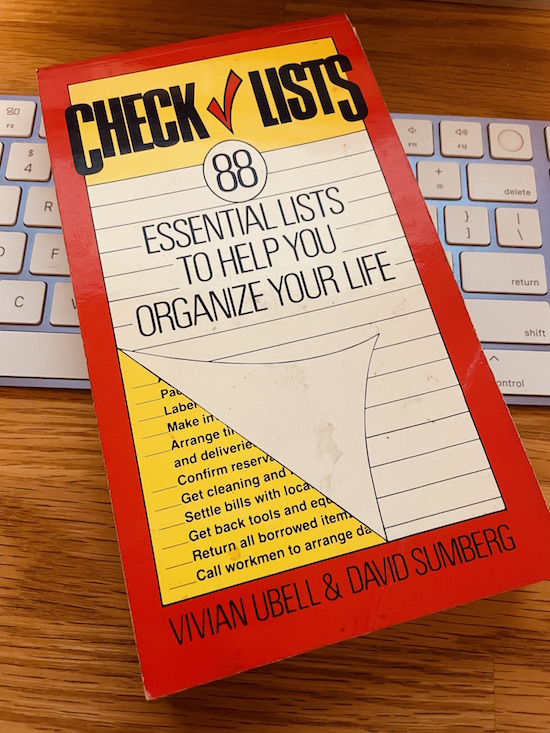
I will grant you that many of these step-by-step To Do lists, such as how to apply to college or for a mortgage are outdated these forty (gasp!) years later, and I can’t say I ever found the lists for buying a summer home or putting my boat in the water particularly useful. Oh, but the aspirational aspect of it all!
The other sections of the book were equally magical, with checklists for packing (for everything from a day at the beach to — I kid you not — sending your child to boarding school) to hosting social events (from children’s birthday parties to showers to Christmas dinners and Passover seders). And even after 20 years as a professional organizer, I still take a gander at the “What to Have” checklists for organizing every space from tool boxes and medicine chests to linen closets and garden sheds.
Even last week, when I was perusing the new books shelves at my public library, I couldn’t bring myself to bypass 52 Ways to Walk: The Surprising Science of Walking for Wellness and Joy, One Week at a Time.
Organize To Reverse a Bad Day
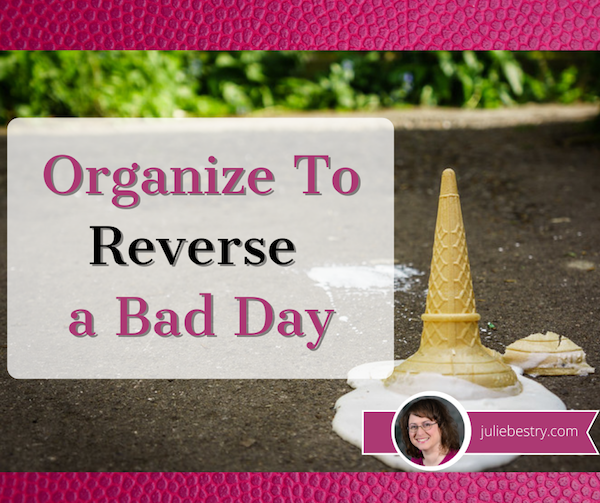
Summer Tears by Mark Seton (Creative Commons License)
In a perfect world, our time and task management wouldn’t depend upon our moods. Unfortunately, we don’t live in a perfect world.
In theory, our organizational systems should be designed so that we can accomplish our goals whether we’re feeling motivated or not. That’s the whole point of a system, to give us a framework when something external or internal prevents us from feeling our usual drive to achieve.
Last September, in Rhymes With Brain: Languishing, Flow, and Building a Better Routine, I wrote:
We also depend on activation energy. Because the hardest part of what we do is the getting started, we have to incentivize ourselves to get going. There are all sorts of ways we can trick ourselves (a little bit) with rewards, like pretty desk accessories or a coffee break, but the problem is that action precedes motivation. We’re not usually psyched to get going until we have already started!
Action precedes motivation. We're not usually psyched to get going until we have already started, whether it's a runner's high or Csikszentmihalyi's flow. Share on XWe may not feel like working out, but once we’re dressed in our best approximation of Venus and Serena, or the yogi of the moment, or whichever quarterback is getting all the endorsements, and have gotten ourselves warmed up, we’re well on our way.
When we lack our usual oomph, our knowledge of the benefits of staying organized may not be enough to keep us motivated to track our expenses, pay our bills on time, file our papers, and stick with our routines, but if we nudge ourselves with giving it just a little try (“just five minutes” or a Pomodoro of 25 minutes or whatever), we may find ourselves able to get into flow.
In other words, well begun is half done.
In that post on languishing, I talked about how to get past the (likely pandemic-induced) blahs and generate flow. We looked at several rhymes-with-brain solutions:
- Abstain from the distractions that steal your focus.
- Retrain your brain by shaking up the synapses and making different connections.
- Restrain yourself from frequenting the people who eating up your time and energy.
- Constrain your work areas and minimize the space they take up to keep from spending all your energy looking for your supplies and resources instead of using them to achieve your goals.
- Contain those items in the areas you’ve constrained (above).
- Maintain your successful routines.
- Attain (and explain) knowledge to keep your brain active.
- Gain momentum and jump-start your enthusiasm.
If you haven’t read that post, skedaddle over to it first, as conquering languishing might be just what you need.
BEYOND LANGUISHING
The problem with productivity is that sometimes, we’ll be going along just fine and hit a brick wall. If languishing is the “blah,” a really bad day is the “waaaaaaaaah.”
Judith Viorst captured it best in the title Alexander and the Terrible, Horrible, No Good, Very Bad Day. Whether you remember it from childhood, babysitting days, or from parenthood, you know what she means. There are days that can go wrong and completely wreck our moods and take our whole day off course.




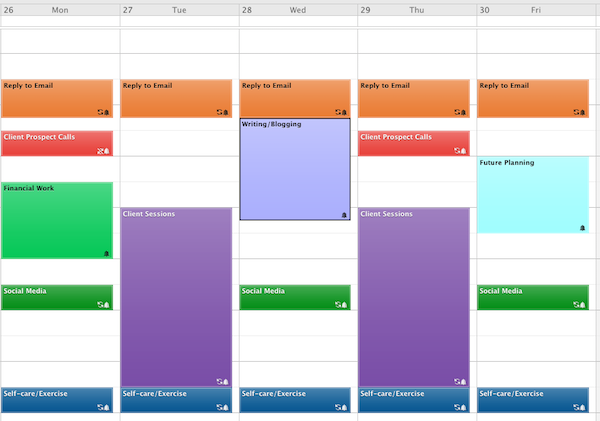









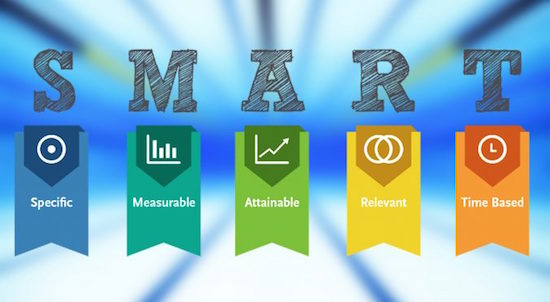
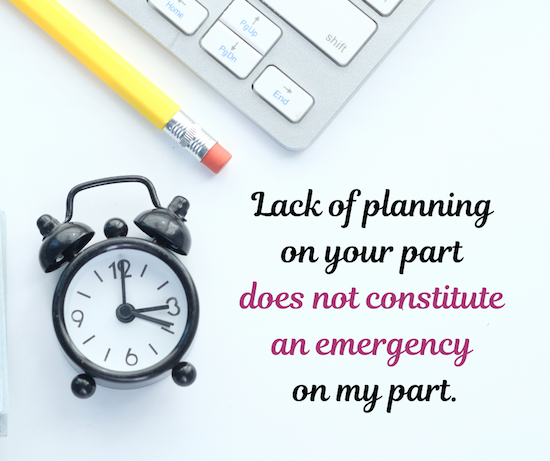



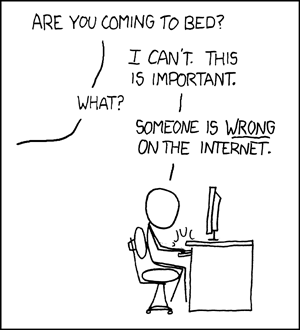
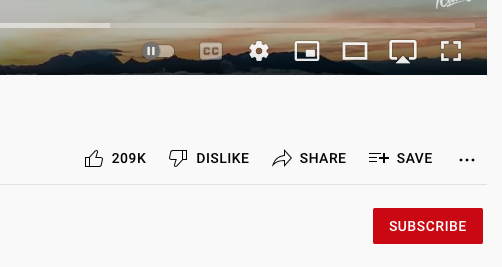
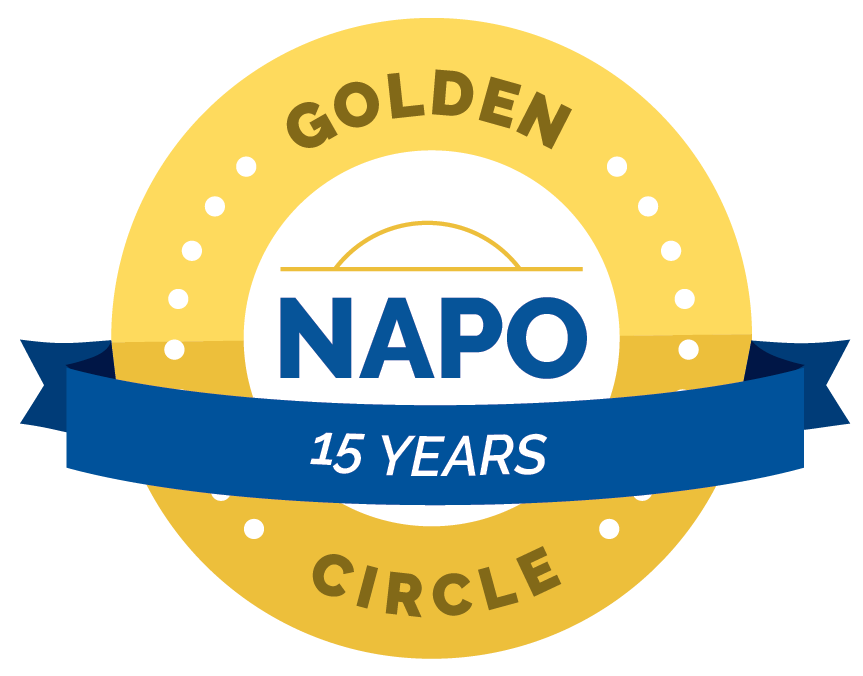
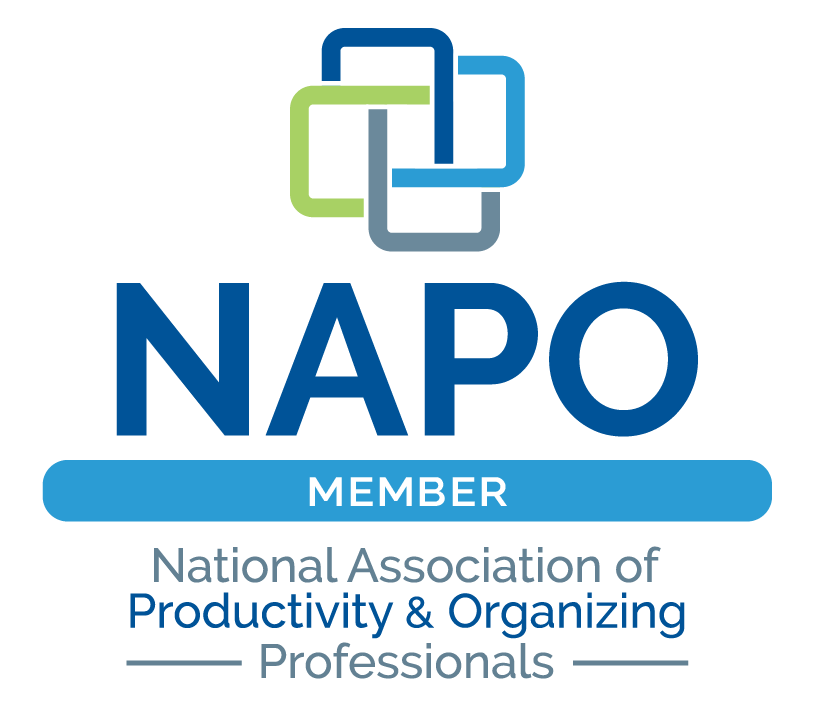
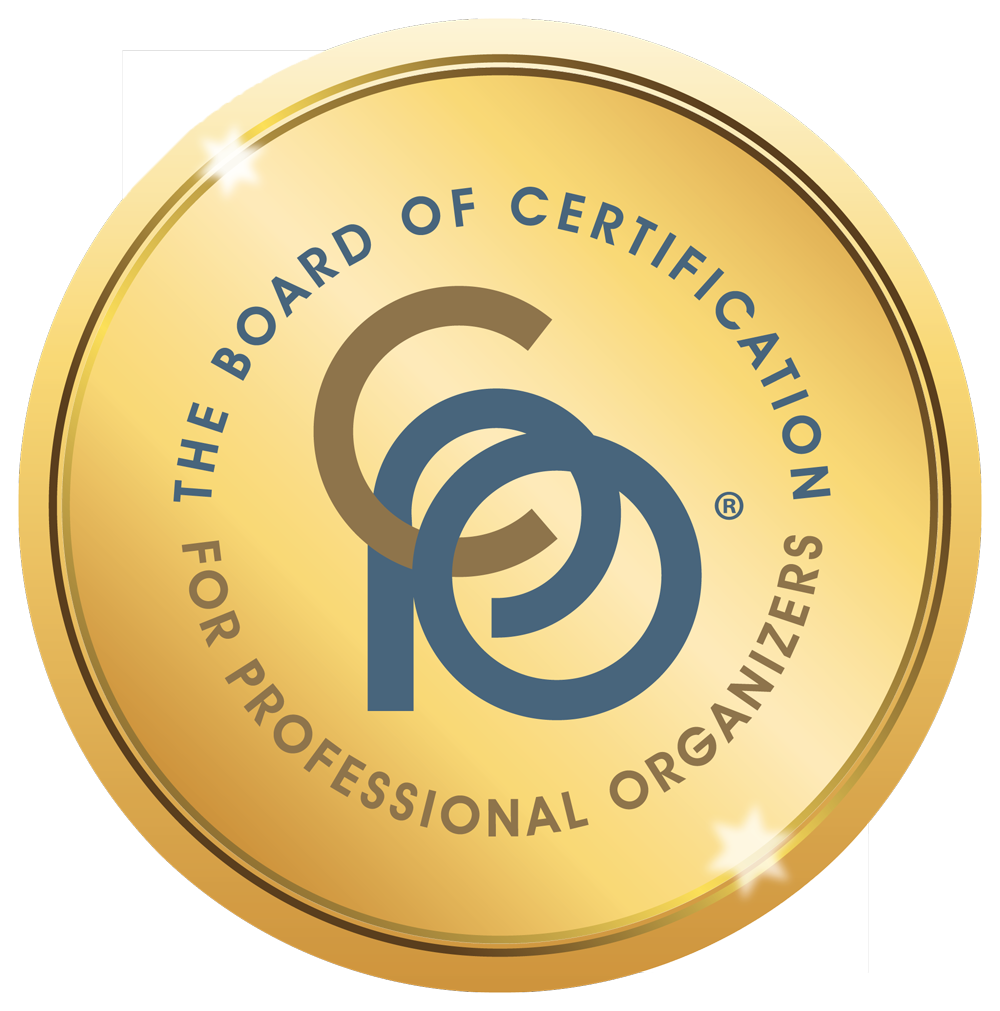
Follow Me